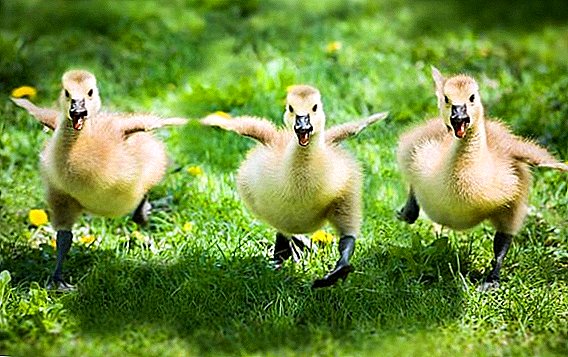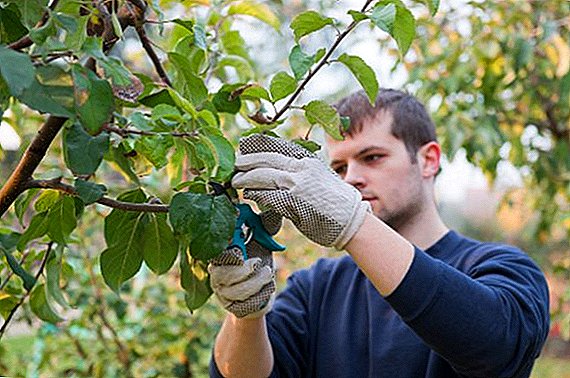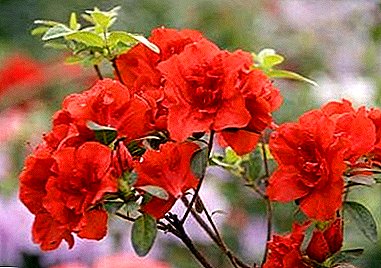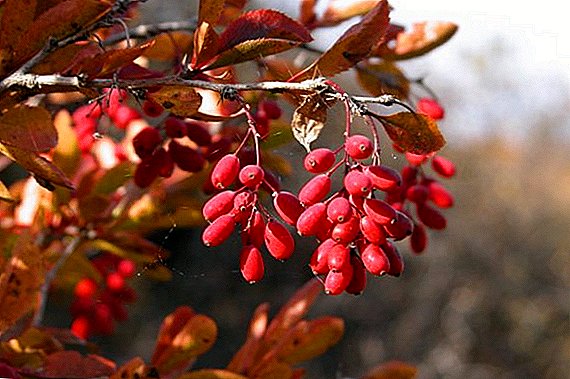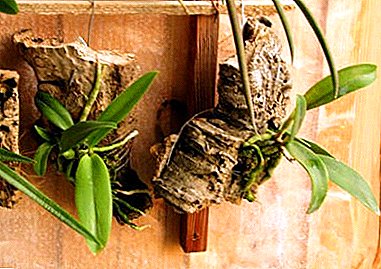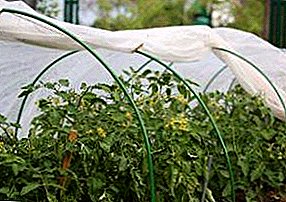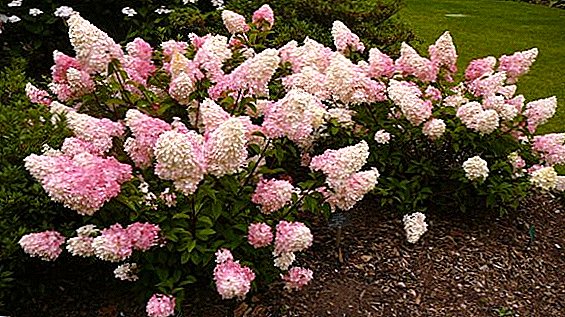 Hydrangea paniculata - plant of amazing beauty, with many species, each of which finds its admirers.
Hydrangea paniculata - plant of amazing beauty, with many species, each of which finds its admirers.
Hortensia grown in pots on the balconies, it is decorated with home and city flower beds.
If you have a place near the house or at the cottage that you want to transform, pay attention to this beautiful flowering plant.
Hydrangea paniculata: features of the plant
 It is difficult to call a hydrangea paniculata a flower, it is rather a shrub or a tree reaching a height of up to 10 m. It has unusual pyramidal inflorescences about 25-30 cm in length, similar to fluffy panicles.
It is difficult to call a hydrangea paniculata a flower, it is rather a shrub or a tree reaching a height of up to 10 m. It has unusual pyramidal inflorescences about 25-30 cm in length, similar to fluffy panicles.
Hydrangea flowers are sterile, that is, not giving fruit. The plant blooms from June to October, changing the color of the inflorescences throughout the season. In the beginning, the flowers are creamy white, then pure white, gradually turning pink. And by the end of flowering, in October, the hydrangea paniculata changes its color to reddish with green splashes.
The plant has more than 25 varieties, of which the most common are "Matilda", "Kyushu", "Unic" and "Grandiflora". These varieties have the largest, bright and fragrant flowers.
The plant can rightly be called the eastern beauty, since the homeland of the hydrangea is paniculata - China, Japan and the south of Sakhalin. The flower well gets accustomed to the temperate climatic zones, calmly enduring the winter cold and summer heat.
Did you know? Hydrangea inflorescences can be used as dried flowers in handicrafts, flower arrangements and home decorative compositions. To do this, you simply need to cut the inflorescences at the flowering stage, when you like the shade of flowers, and dry them in a suspended state downwards with a cone. After drying, the inflorescence can be used in winter bouquets.
How to plant hydrangea in open ground
 Fans of hydrangea paniculata claim that it is quite simple to grow this plant on their land, its planting and care do not require special skills. The plant grows quite quickly, the inflorescences are born on the shoots already in the year of planting.
Fans of hydrangea paniculata claim that it is quite simple to grow this plant on their land, its planting and care do not require special skills. The plant grows quite quickly, the inflorescences are born on the shoots already in the year of planting.
Lighting for panicle hydrangea
For planting hydrangea paniculata need to choose areas with good light, but it blooms best in partial shade. She loves the bright sun too and grows well under its rays, but then the hydrangea flowers lose their unique “chameleon” color, fade and turn pale.
Flower growing soil
Landing paniculate hydrangea is recommended for a good, lush color. on fertile, loamy, red-soil soils. Does not like sandy, calcareous soils and feels bad on neutral ones - the color of the inflorescences turns pale, and the plant will be weak in general.
On acidic soils, hydrangea blooms brighter and better, therefore, if the soil is not sour enough, you need to add brown peat, sawdust, coniferous soil (spruce or pine compost) when planting the plant. Possible such a variant as planting to hydrangea in the near-stem circles of ground cover plants: moss-shaped saxifrage, various stonecrop.

Important! Ash, lime and chalk are contraindicated for all hydrangeas. Alkaline soil can cause leaf chlorosis in plants.
What should be the humidity for successful growth
Hortensia paniculata is very fond of moisture, it can even live on swampy soil. Therefore, for good growth, abundant flowering and normal plant life, he needs to provide a moist soil within a radius of about 1.5 meters.
Planting hydrangea paniculata in open ground: description of the process
 Planting time determines which year the hydrangea paniculata blooms. If climatic conditions allow, you can land in early spring (March), then the plant will delight with its lush color already in the year of planting. In the northern regions it is better to plant when the soil is already warm enough (April), so that it will take root well and take root. The autumn version of planting hydrangea is also possible, but then it will be necessary to warm it for the winter, and it will bloom next year.
Planting time determines which year the hydrangea paniculata blooms. If climatic conditions allow, you can land in early spring (March), then the plant will delight with its lush color already in the year of planting. In the northern regions it is better to plant when the soil is already warm enough (April), so that it will take root well and take root. The autumn version of planting hydrangea is also possible, but then it will be necessary to warm it for the winter, and it will bloom next year.
On a permanent place, seedlings of the hydrangea paniculata are planted at the age of 4-5. The root system of the plant expands in breadth much more than the crown, that is, a place to plant should be prepared based on the size of the root and seedling.
Experienced gardeners who know how to plant a paniculate hydrangea., they are advised to make pits with dimensions of 50 × 50 cm. But sometimes, with strongly developed roots, the depth of the planting pit can reach up to 80 cm. The distance between the plants is about 2-2.5 m.
Then, up to 3 buckets of water are poured into the pit and left overnight so that the moisture is absorbed into the ground. Next morning you need to fill the pit with the substrate from fertile soil, peat, humus and sand in the ratio: 2: 2: 1: 1, and also add a mixture of mineral and organic fertilizers (65 g of superphosphate + 25 g of urea + 25 g of potassium sulphate).
Before planting, it is necessary to trim the roots and annual shoots, leaving only 3-5 pairs of buds. Then the seedling is placed in a hole, crushed with soil, mulched with a compost layer, peat.
Care tips for paniculate hydrangea in the open field
 Hydrangea paniculata is completely unpretentious and can grow even in harsh conditions, such as gassed places near highways. But in order to get a healthy hydrangea in the garden with large flowering pyramids of different shades, it is necessary to ensure proper care of the plant.
Hydrangea paniculata is completely unpretentious and can grow even in harsh conditions, such as gassed places near highways. But in order to get a healthy hydrangea in the garden with large flowering pyramids of different shades, it is necessary to ensure proper care of the plant.
Peculiarities of irrigation of paniculate hydrangea
The plant is very fond of the abundance of moisture, therefore, the soil around the bush must be constantly moistened. Especially during hot dry summers, the soil should not be allowed to dry under hydrangea.
Watering the plant should be once a week, very abundant, consuming up to 30 liters of water per square meter of soil around the bush. In rainy periods, watering is reduced. It is recommended to add potassium permanganate (potassium permanganate) to the water during watering. Also, for the preservation of moisture in the soil it is necessary to regularly mulch the soil under a bush.
Did you know? The fact that hydrangea is a very moisture-loving plant, says one of its name. The Latin name for hydrangea hydrangea translates as "vessel for water": hydor - water and aggeion - vessel.
Plant nutrition
Feed for hydrangea paniculata contribute quite often. This fast-flowering shrub requires many nutrients. In the fall - mineral fertilizers, in the spring - urea solution (20 g per bucket of water, 2 buckets per plant).
 At the beginning of the growing season, the plant will benefit from green fertilizer (for example, from young nettle) diluted with water 1:10. On a two-meter hydrangea is 1 bucket solution.
At the beginning of the growing season, the plant will benefit from green fertilizer (for example, from young nettle) diluted with water 1:10. On a two-meter hydrangea is 1 bucket solution.
In addition, once every two weeks with watering make a mullein infusion (3 liters of water poured into a bucket of manure and insist for three days). Before using 1 liter of infusion must be diluted in a bucket of water.
During the formation of inflorescences, mineral fertilizer is applied twice twice with an interval of 14-15 days.
How to trim a hydrangea bush
Care for paniculate hydrangea involves mandatory regular pruning of the plant. The inflorescences that survived until late autumn are pruned so that the branches do not break under the snow. Regular pruning in spring, before flowering, also has a beneficial effect on the lush and long color of hydrangea.
Weak shoots and those that impede the growth of the plant as a whole, are removed completely. Frozen over the winter shoots pruned to healthy wood, and they bloom the same year. One-year shoots are selected, about ten of the strongest, they are cut to 3-5 pairs of buds to form a beautiful bush shape. If the pruning is late, the plant does not develop well and may not bloom.
Old bushes can also be rejuvenated by pruning on the stump. This will allow for the second year to restore the decorativeness of the bush and to preserve the possibility of further reproduction of hydrangea.
How to save the hydrangea in winter
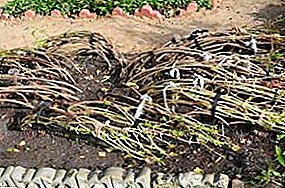 Although hydrangea paniculata has good resistance to temperature extremes and cold weather, it is better to take care of its safe wintering in advance. For this, the roots - the most vulnerable part of the plant - should be carefully covered.
Although hydrangea paniculata has good resistance to temperature extremes and cold weather, it is better to take care of its safe wintering in advance. For this, the roots - the most vulnerable part of the plant - should be carefully covered.
Good insulation can serve as rotted manure, peat or dry leaves, which are placed under the bush in a thick layer (20 cm). Thus, cold winters will not damage the hydrangea roots.
Reproduction of paniculata hydrangea
Consider how to propagate paniculate hydrangea layering and cuttings. For harvesting cuttings use the remaining shoots in the spring pruning.
It is best to cut the cuttings in early June, when the shoots contain a sufficient amount of moisture. Good material for grafting is the bottom of the trunks, which you need to pinch off with your hands, and not shears.
Cuttings are harvested with 3-5 buds, up to 10 cm long, then they are soaked for two days in a growth stimulator.
 Hydrangea can be propagated by layering, but this method is less productive. Young flexible branches that grow from the side are bent away from the uterine bush and pin them to the ground (in a hole 15 cm deep), tying the ends of the branches to the pegs.
Hydrangea can be propagated by layering, but this method is less productive. Young flexible branches that grow from the side are bent away from the uterine bush and pin them to the ground (in a hole 15 cm deep), tying the ends of the branches to the pegs.
Ground ground shoots need to be powdered with a light mixture of peat and soil and moisten the ground. When the bends form their own roots, they can be separated from the mother bush and transplanted.
Diseases and pests of panicle hydrangea
Panicled hydrangeas are sometimes exposed to diseases and pest attacks. The most common disease is powdery mildew. It is necessary to fight it with the help of the solution "Fundazola" with water (20-25 g per 10 l of water). Another suitable remedy is Bordeaux liquid (100 g per 10-12 l of water).
Hydrangea attacks most often among pests. aphid. Garlic tincture will help to cope with it: 250 g of peeled garlic cloves are crushed and 10 liters of water are poured. Insist for two days, then add 50 g of grated soap, mix and spray once a week until the aphid disappears.


